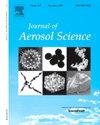Study on the atomization characteristics of gel by liquid carbon dioxide
IF 3.9
3区 环境科学与生态学
Q2 ENGINEERING, CHEMICAL
引用次数: 0
Abstract
Super absorbent polymer (SAP) gel materials have emerged as a focal point of research in the firefighting domain, owing to their remarkable water retention capabilities and inherent flexibility. However, due to the high viscosity of the gel material, it is usually treated with a medium atomization method. Liquid CO2 has a very high expansion coefficient, and when released, it can effectively drive away oxygen in the fire area. With the development of carbon capture and utilization (CCU) technology, more and more CO2 being stored in liquid form in cylinders, making it meaningful to explore using liquid CO2 as a medium for atomizing the gel. This paper proposes using the liquid CO2 as the atomization medium and designs a hybrid atomization system. The system utilizes the large amount of energy released when liquid carbon dioxide turns into gas, thereby enhancing the atomization effect for high-viscosity fluids and helping to carry out carbon capture and utilization (CCU) work simultaneously. The influences of the inlet diameter of liquid CO2 (d0), the number of outlet holes of mixed liquid (Nholes), and the gel concentration (C) on the atomization characteristics of the gel jet were investigated. The research results indicate that with an increase in d0, the spray range, spray width, and spray cone angle increase correspondingly, while the spray particle sizes D32 and Dv90 decrease accordingly. With an increase in Nholes, the spray range and the particle sizes D32 and Dv90 show an increasing trend, while the spray cone angle and spray width decrease correspondingly. As the gel concentration increases, the spray range, spray width, and spray cone angle decrease, while the particle sizes D32 and Dv90 increase accordingly.
求助全文
约1分钟内获得全文
求助全文
来源期刊

Journal of Aerosol Science
环境科学-工程:化工
CiteScore
8.80
自引率
8.90%
发文量
127
审稿时长
35 days
期刊介绍:
Founded in 1970, the Journal of Aerosol Science considers itself the prime vehicle for the publication of original work as well as reviews related to fundamental and applied aerosol research, as well as aerosol instrumentation. Its content is directed at scientists working in engineering disciplines, as well as physics, chemistry, and environmental sciences.
The editors welcome submissions of papers describing recent experimental, numerical, and theoretical research related to the following topics:
1. Fundamental Aerosol Science.
2. Applied Aerosol Science.
3. Instrumentation & Measurement Methods.
 求助内容:
求助内容: 应助结果提醒方式:
应助结果提醒方式:


